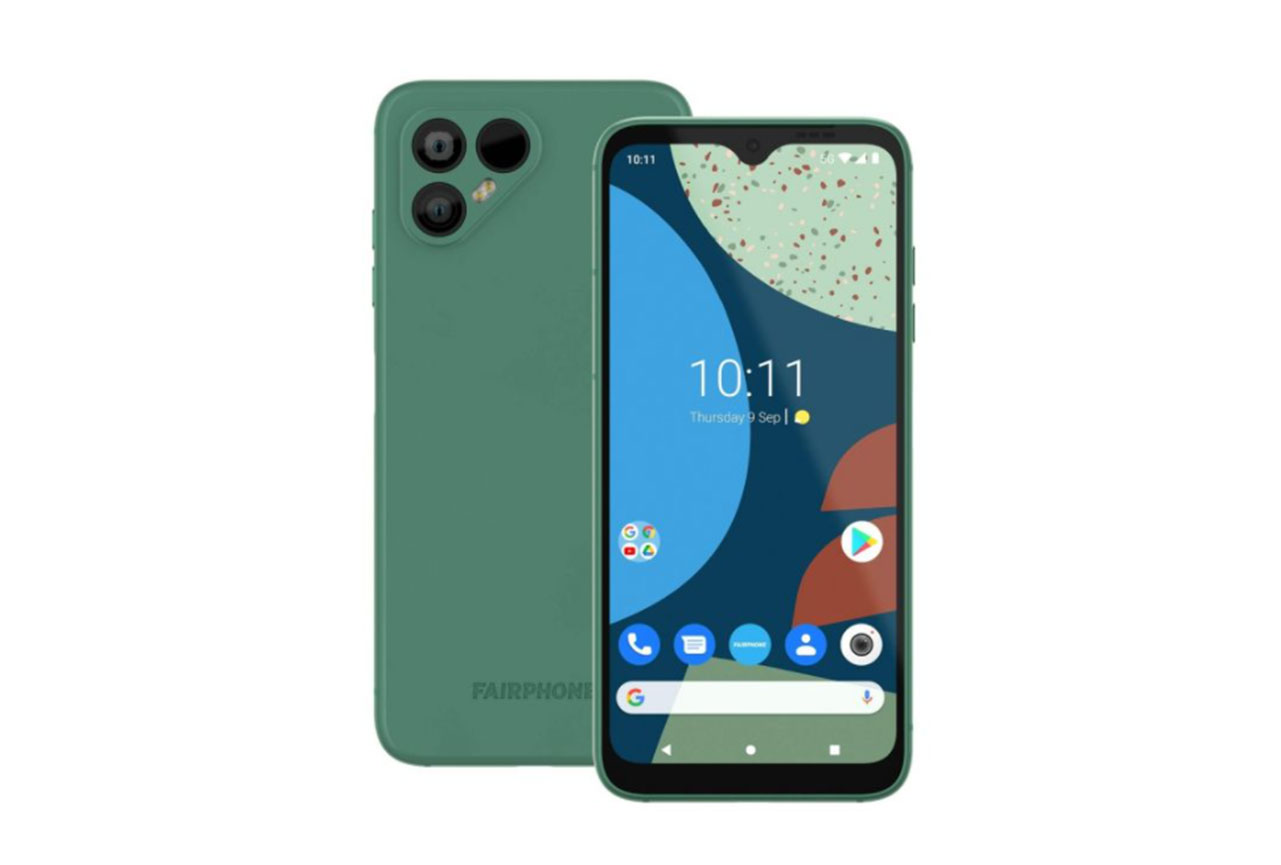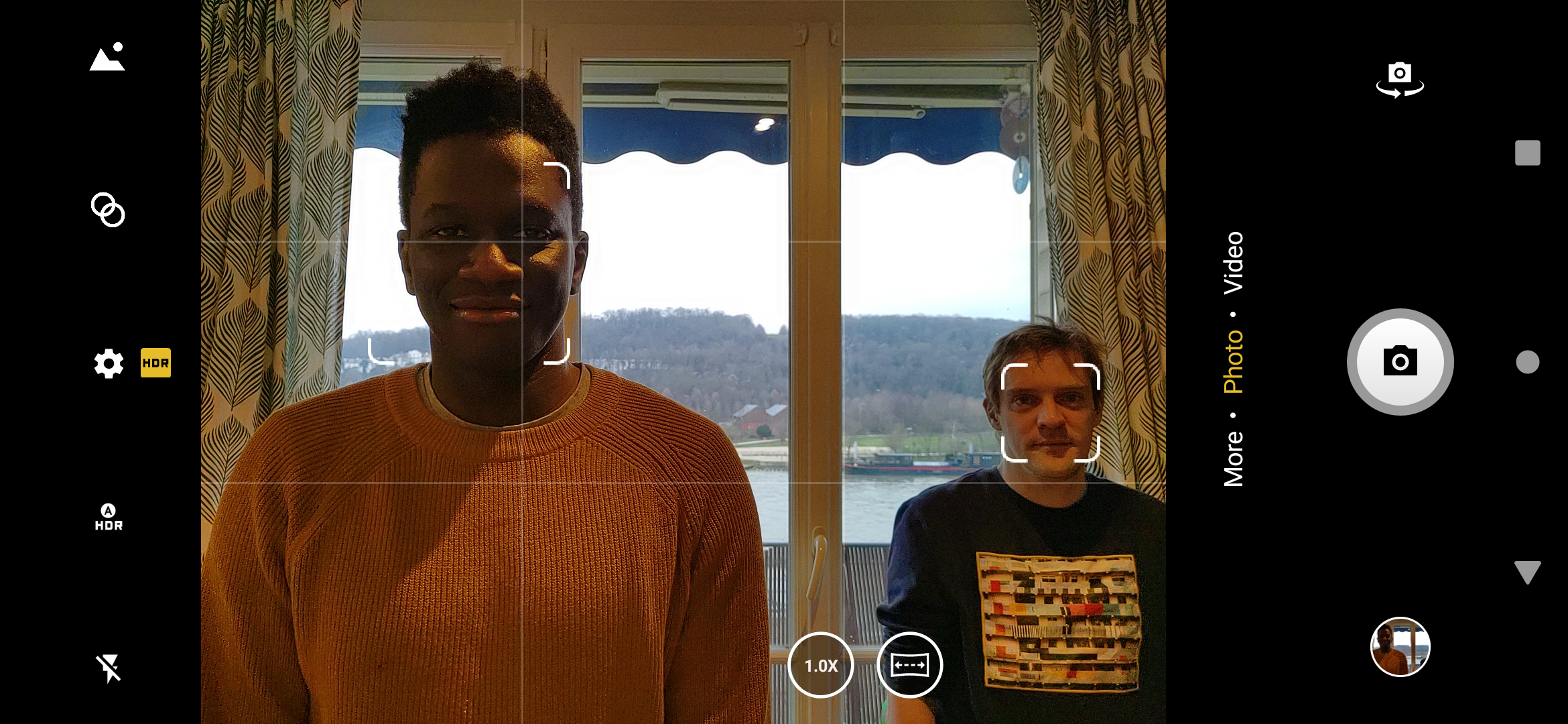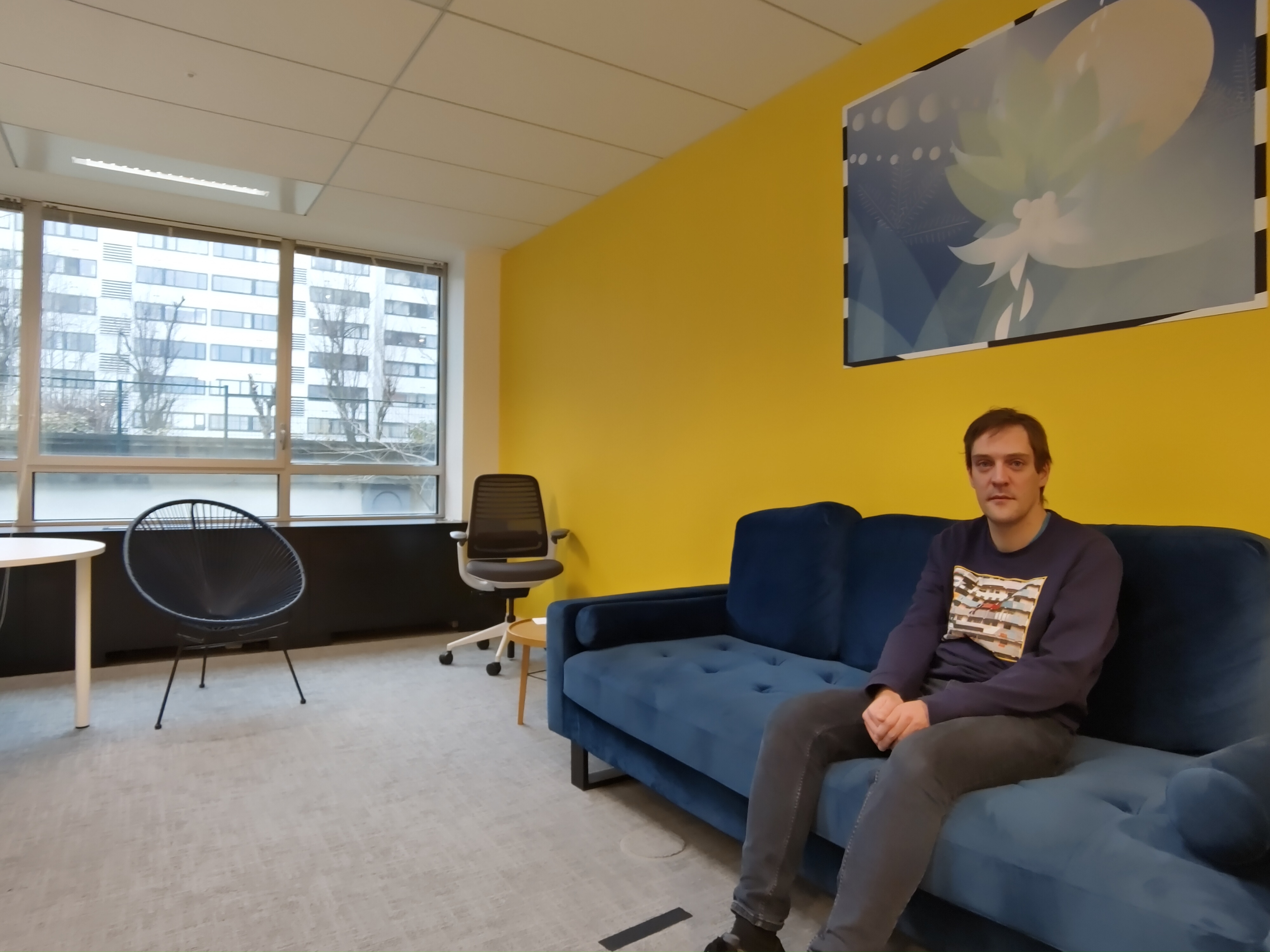We put the Fairphone 4 through our rigorous DXOMARK Camera test suite to measure its performance in photo, video, and zoom quality from an end-user perspective. This vendible breaks lanugo how the device fared in a variety of tests and several worldwide use cases and is intended to highlight the most important results of our testing with an pericope of the captured data.
Overview
Key camera specifications:
- Primary: 48MP 1/2″ sensor, 0.8 μm pixels, f/1.6 vent lens, AF, OIS
- Ultra-Wide: 48MP sensor, 1.6 μm pixels, f/2.2 vent lens, AF
- Video: 4K at 30fps, 1080p at 30/60fps
 Fairphone 4
Fairphone 4

92
camera
57
Honor Magic4 Ultimate
Best: Honor Magic4 Ultimate (111)
90
Apple iPhone 13 Pro Max
Best: Apple iPhone 13 Pro Max (107)
81
Asus Smartphone for Snapdragon Insiders
Best: Asus Smartphone for Snapdragon Insiders (109)
78
Xiaomi Mi 11
Best: Xiaomi Mi 11 (111)
73
Honor Magic4 Ultimate
Best: Honor Magic4 Ultimate (102)
68
Google Pixel 6
Best: Google Pixel 6 (77)
14
Huawei Mate 40 Pro
Best: Huawei Mate 40 Pro (82)
25
Huawei P50 Pro
Best: Huawei P50 Pro (80)
33
Apple iPhone 13 Pro Max
Best: Apple iPhone 13 Pro Max (80)
55
Honor Magic4 Ultimate
Best: Honor Magic4 Ultimate (140)
30
Honor Magic4 Ultimate
Best: Honor Magic4 Ultimate (58)
85
Apple iPhone 13 Pro Max
Best: Apple iPhone 13 Pro Max (118)
90
Honor Magic4 Ultimate
Best: Honor Magic4 Ultimate (107)
70
Apple iPhone 13 Pro Max
Best: Apple iPhone 13 Pro Max (109)
51
Oppo Reno6 Pro 5G (Snapdragon)
Best: Oppo Reno6 Pro 5G (Snapdragon) (99)
68
Apple iPhone 13 Pro Max
Best: Apple iPhone 13 Pro Max (105)
71
Oppo Find X2 Pro
Best: Oppo Find X2 Pro (94)
80
Vivo X70 Pro
Best: Vivo X70 Pro (103)
Position in Global Ranking

124
th
[glossary_exclude]1. Honor Magic4 Ultimate[/glossary_exclude]
146
[glossary_exclude]2. Huawei P50 Pro[/glossary_exclude]
144
[glossary_exclude]3. Xiaomi Mi 11 Ultra[/glossary_exclude]
143
[glossary_exclude]4. Huawei Mate 40 Pro [/glossary_exclude]
139
[glossary_exclude]5. Apple iPhone 13 Pro Max[/glossary_exclude]
137
[glossary_exclude]5. Apple iPhone 13 Pro[/glossary_exclude]
137
[glossary_exclude]7. Huawei Mate 40 Pro[/glossary_exclude]
136
[glossary_exclude]8. Google Pixel 6 Pro[/glossary_exclude]
135
[glossary_exclude]8. Vivo X70 Pro [/glossary_exclude]
135
[glossary_exclude]10. Asus Smartphone for Snapdragon Insiders[/glossary_exclude]
133
[glossary_exclude]10. Xiaomi Mi 10 Ultra[/glossary_exclude]
133
[glossary_exclude]12. Google Pixel 6[/glossary_exclude]
132
[glossary_exclude]12. Huawei P40 Pro[/glossary_exclude]
132
[glossary_exclude]14. Honor Magic4 Pro[/glossary_exclude]
131
[glossary_exclude]14. Oppo Find X3 Pro[/glossary_exclude]
131
[glossary_exclude]14. Samsung Galaxy S22 Ultra (Snapdragon)[/glossary_exclude]
131
[glossary_exclude]14. Samsung Galaxy S22 Ultra (Exynos)[/glossary_exclude]
131
[glossary_exclude]14. Vivo X70 Pro (MediaTek)[/glossary_exclude]
131
[glossary_exclude]14. Vivo X50 Pro [/glossary_exclude]
131
[glossary_exclude]14. Xiaomi 12 Pro[/glossary_exclude]
131
[glossary_exclude]21. Apple iPhone 13 mini[/glossary_exclude]
130
[glossary_exclude]21. Apple iPhone 13[/glossary_exclude]
130
[glossary_exclude]21. Apple iPhone 12 Pro Max[/glossary_exclude]
130
[glossary_exclude]21. Google Pixel 6a[/glossary_exclude]
130
[glossary_exclude]25. Apple iPhone 12 Pro[/glossary_exclude]
128
[glossary_exclude]25. Vivo X60 Pro [/glossary_exclude]
128
[glossary_exclude]25. Xiaomi Mi 11 Pro[/glossary_exclude]
128
[glossary_exclude]25. Xiaomi Mi 10 Pro[/glossary_exclude]
128
[glossary_exclude]29. OnePlus 10 Pro[/glossary_exclude]
127
[glossary_exclude]30. Oppo Find X2 Pro[/glossary_exclude]
126
[glossary_exclude]30. Samsung Galaxy S22 (Exynos)[/glossary_exclude]
126
[glossary_exclude]30. Samsung Galaxy S22 (Exynos)[/glossary_exclude]
126
[glossary_exclude]30. Samsung Galaxy S20 Ultra 5G (Exynos)[/glossary_exclude]
126
[glossary_exclude]34. Apple iPhone 11 Pro Max[/glossary_exclude]
124
[glossary_exclude]34. OnePlus 9 Pro[/glossary_exclude]
124
[glossary_exclude]34. Samsung Galaxy Z Fold3 5G[/glossary_exclude]
124
[glossary_exclude]37. Samsung Galaxy S21 Ultra 5G (Snapdragon)[/glossary_exclude]
123
[glossary_exclude]37. Xiaomi 12[/glossary_exclude]
123
[glossary_exclude]39. Apple iPhone 12 mini[/glossary_exclude]
122
[glossary_exclude]39. Apple iPhone 12[/glossary_exclude]
122
[glossary_exclude]39. Oppo Find X5[/glossary_exclude]
122
[glossary_exclude]42. Oppo Reno6 Pro 5G (Snapdragon)[/glossary_exclude]
121
[glossary_exclude]42. Samsung Galaxy S21 Ultra 5G (Exynos)[/glossary_exclude]
121
[glossary_exclude]44. Asus Zenfone 8[/glossary_exclude]
120
[glossary_exclude]44. Google Pixel 5[/glossary_exclude]
120
[glossary_exclude]44. Realme GT 2 Pro[/glossary_exclude]
120
[glossary_exclude]44. Samsung Galaxy S21 FE 5G (Snapdragon)[/glossary_exclude]
120
[glossary_exclude]44. Samsung Galaxy Note20 Ultra 5G (Exynos)[/glossary_exclude]
120
[glossary_exclude]44. Samsung Galaxy Note20 (Exynos)[/glossary_exclude]
120
[glossary_exclude]44. Samsung Galaxy Note 20 (Exynos)[/glossary_exclude]
120
[glossary_exclude]44. Vivo X60 Pro 5G (Snapdragon)[/glossary_exclude]
120
[glossary_exclude]44. Xiaomi Mi 11[/glossary_exclude]
120
[glossary_exclude]53. Apple iPhone 11[/glossary_exclude]
119
[glossary_exclude]53. Samsung Galaxy S21 5G (Snapdragon)[/glossary_exclude]
119
[glossary_exclude]53. Samsung Galaxy S21 5G (Snapdragon)[/glossary_exclude]
119
[glossary_exclude]56. Apple iPhone SE (2022)[/glossary_exclude]
118
[glossary_exclude]56. Asus Zenfone 8 Flip[/glossary_exclude]
118
[glossary_exclude]56. OnePlus 8 Pro[/glossary_exclude]
118
[glossary_exclude]56. Samsung Galaxy Z Flip3 5G[/glossary_exclude]
118
[glossary_exclude]56. Vivo X60 Pro 5G (Exynos)[/glossary_exclude]
118
[glossary_exclude]56. Xiaomi Mi 10T Pro 5G[/glossary_exclude]
118
[glossary_exclude]62. Motorola Whet [/glossary_exclude]
117
[glossary_exclude]62. Samsung Galaxy Note20 Ultra 5G (Snapdragon)[/glossary_exclude]
117
[glossary_exclude]62. TCL 20 Pro 5G[/glossary_exclude]
117
[glossary_exclude]62. Xiaomi 11T Pro[/glossary_exclude]
117
[glossary_exclude]66. OnePlus Nord 2 5G[/glossary_exclude]
116
[glossary_exclude]66. Samsung Galaxy S21 5G (Exynos)[/glossary_exclude]
116
[glossary_exclude]66. Samsung Galaxy S21 5G (Exynos)[/glossary_exclude]
116
[glossary_exclude]66. Samsung Galaxy Note 10 5G (Exynos)[/glossary_exclude]
116
[glossary_exclude]70. OnePlus 9[/glossary_exclude]
115
[glossary_exclude]70. Oppo Reno 10x Zoom[/glossary_exclude]
115
[glossary_exclude]70. Oppo Find X3 Neo[/glossary_exclude]
115
[glossary_exclude]70. Samsung Galaxy S20 FE (Exynos)[/glossary_exclude]
115
[glossary_exclude]70. Sony Xperia 1 III[/glossary_exclude]
115
[glossary_exclude]75. Motorola Whet 30 Pro[/glossary_exclude]
114
[glossary_exclude]75. Vivo X51 5G[/glossary_exclude]
114
[glossary_exclude]77. Google Pixel 4[/glossary_exclude]
113
[glossary_exclude]78. Black Shark 4S Pro[/glossary_exclude]
112
[glossary_exclude]78. Huawei P40[/glossary_exclude]
112
[glossary_exclude]78. Oppo Reno5 Pro 5G[/glossary_exclude]
112
[glossary_exclude]78. Samsung Galaxy Note20 (Snapdragon)[/glossary_exclude]
112
[glossary_exclude]78. Sony Xperia 1 II[/glossary_exclude]
112
[glossary_exclude]83. Google Pixel 4a[/glossary_exclude]
111
[glossary_exclude]83. OnePlus 8T[/glossary_exclude]
111
[glossary_exclude]83. Sony Xperia 5 II[/glossary_exclude]
111
[glossary_exclude]83. Xiaomi Mi 11i[/glossary_exclude]
111
[glossary_exclude]83. Xiaomi Mi 11 Lite 5G[/glossary_exclude]
111
[glossary_exclude]88. LG Wing[/glossary_exclude]
110
[glossary_exclude]89. Samsung Galaxy Z Fold2 5G[/glossary_exclude]
109
[glossary_exclude]89. Samsung Galaxy Z Fold 2[/glossary_exclude]
109
[glossary_exclude]91. OnePlus Nord[/glossary_exclude]
108
[glossary_exclude]91. Oppo Reno4 Pro 5G[/glossary_exclude]
108
[glossary_exclude]91. Oppo A94 5G[/glossary_exclude]
108
[glossary_exclude]91. Xiaomi Redmi K40 Pro [/glossary_exclude]
108
[glossary_exclude]91. Xiaomi 11T[/glossary_exclude]
108
[glossary_exclude]96. Oppo Reno6 5G[/glossary_exclude]
107
[glossary_exclude]96. ZTE Axon 30 Ultra[/glossary_exclude]
107
[glossary_exclude]98. Oppo Find X5 Lite[/glossary_exclude]
106
[glossary_exclude]98. Realme GT Neo 2 5G[/glossary_exclude]
106
[glossary_exclude]98. Xiaomi Redmi Note 10 Pro[/glossary_exclude]
106
[glossary_exclude]101. Motorola Whet 20 Pro[/glossary_exclude]
105
[glossary_exclude]101. Oppo Reno4 5G[/glossary_exclude]
105
[glossary_exclude]101. Oppo Find X3 Lite[/glossary_exclude]
105
[glossary_exclude]101. Oppo Find X2 Neo[/glossary_exclude]
105
[glossary_exclude]101. Realme GT Neo[/glossary_exclude]
105
[glossary_exclude]101. Samsung Galaxy A72[/glossary_exclude]
105
[glossary_exclude]101. Samsung Galaxy A53 5G[/glossary_exclude]
105
[glossary_exclude]101. Samsung Galaxy A52s 5G[/glossary_exclude]
105
[glossary_exclude]101. Samsung Galaxy A33 5G[/glossary_exclude]
105
[glossary_exclude]101. Vivo V21 5G[/glossary_exclude]
105
[glossary_exclude]111. Apple iPhone SE (2020)[/glossary_exclude]
103
[glossary_exclude]111. POCO X3 NFC[/glossary_exclude]
103
[glossary_exclude]111. Realme 8 Pro[/glossary_exclude]
103
[glossary_exclude]114. OnePlus Nord CE 5G[/glossary_exclude]
102
[glossary_exclude]114. Samsung Galaxy A52 5G[/glossary_exclude]
102
[glossary_exclude]114. Xiaomi Redmi Note 11 Pro 5G[/glossary_exclude]
102
[glossary_exclude]117. Oppo Reno5 Pro 5G[/glossary_exclude]
100
[glossary_exclude]118. Vivo Y76 5G[/glossary_exclude]
99
[glossary_exclude]119. Xiaomi Mi 10T 5G[/glossary_exclude]
98
[glossary_exclude]120. Oppo A77 5G[/glossary_exclude]
97
[glossary_exclude]120. Xiaomi Redmi Note 11S 5G[/glossary_exclude]
97
[glossary_exclude]122. Honor Magic4 Lite 5G[/glossary_exclude]
95
[glossary_exclude]123. Vivo Y72 5G[/glossary_exclude]
94
[glossary_exclude]124. Fairphone 4[/glossary_exclude]
92
[glossary_exclude]124. Xiaomi Redmi Note 10S[/glossary_exclude]
92
[glossary_exclude]126. Samsung Galaxy A12[/glossary_exclude]
90
[glossary_exclude]127. Samsung Galaxy A22 5G[/glossary_exclude]
89
[glossary_exclude]128. Honor X7[/glossary_exclude]
88
[glossary_exclude]128. Samsung Galaxy A71 5G[/glossary_exclude]
88
[glossary_exclude]128. Xiaomi Redmi Note 11[/glossary_exclude]
88
[glossary_exclude]128. Xiaomi Redmi 10 2022[/glossary_exclude]
88
[glossary_exclude]132. Crosscall Action-X5[/glossary_exclude]
87
[glossary_exclude]132. Samsung Galaxy A51 5G[/glossary_exclude]
87
[glossary_exclude]132. Sony Xperia 1[/glossary_exclude]
87
[glossary_exclude]132. ZTE Axon 20 5G[/glossary_exclude]
87
[glossary_exclude]136. Nokia 8.3 5G[/glossary_exclude]
86
[glossary_exclude]137. Oppo A16s 5G[/glossary_exclude]
80
[glossary_exclude]138. Samsung Galaxy A50[/glossary_exclude]
76
Position in High-End Ranking

21
st
[glossary_exclude]1. Google Pixel 6[/glossary_exclude]
132
[glossary_exclude]2. Google Pixel 6a[/glossary_exclude]
130
[glossary_exclude]3. Apple iPhone SE (2022)[/glossary_exclude]
118
[glossary_exclude]3. Xiaomi Mi 10T Pro 5G[/glossary_exclude]
118
[glossary_exclude]5. TCL 20 Pro 5G[/glossary_exclude]
117
[glossary_exclude]6. OnePlus 8T[/glossary_exclude]
111
[glossary_exclude]7. Xiaomi Redmi K40 Pro [/glossary_exclude]
108
[glossary_exclude]7. Xiaomi 11T[/glossary_exclude]
108
[glossary_exclude]9. Oppo Reno6 5G[/glossary_exclude]
107
[glossary_exclude]10. Oppo Find X5 Lite[/glossary_exclude]
106
[glossary_exclude]10. Realme GT Neo 2 5G[/glossary_exclude]
106
[glossary_exclude]12. Oppo Reno4 5G[/glossary_exclude]
105
[glossary_exclude]12. Oppo Find X3 Lite[/glossary_exclude]
105
[glossary_exclude]12. Samsung Galaxy A72[/glossary_exclude]
105
[glossary_exclude]12. Samsung Galaxy A53 5G[/glossary_exclude]
105
[glossary_exclude]12. Samsung Galaxy A52s 5G[/glossary_exclude]
105
[glossary_exclude]12. Vivo V21 5G[/glossary_exclude]
105
[glossary_exclude]18. Samsung Galaxy A52 5G[/glossary_exclude]
102
[glossary_exclude]19. Oppo Reno5 Pro 5G[/glossary_exclude]
100
[glossary_exclude]20. Xiaomi Mi 10T 5G[/glossary_exclude]
98
[glossary_exclude]21. Fairphone 4[/glossary_exclude]
92
[glossary_exclude]22. Samsung Galaxy A71 5G[/glossary_exclude]
88
[glossary_exclude]23. Crosscall Action-X5[/glossary_exclude]
87
[glossary_exclude]23. Samsung Galaxy A51 5G[/glossary_exclude]
87
[glossary_exclude]23. ZTE Axon 20 5G[/glossary_exclude]
87
Pros
- Low noise levels in unexceptionable light and indoor conditions
- Good detail in unexceptionable light
- Accurate white balance
Cons
- Underexposure
- Limited dynamic range
- Unnatural rendering of visionless skin tones (reddish cast)
- Lack of detail in indoor and low light images
- Strong white wastefulness tint on night shots with flash
- No bokeh mode
- Narrower field of view on ultra-wide than many competitors
Following on the Fairphone 3, the Fairphone 4 is the latest iteration of the company’s sustainable smartphone and comes with overall refreshed hardware, including the wing of an ultra-wide camera and a wider vent on the primary camera. Both camera modules use 48MP 1/2″ image sensors.
Despite the technology update, the Fairphone 4 does not come tropical to the category leaders Google Pixel 6 and Apple iPhone SE and occupies one of the lower spots in the DXOMARK Camera ranking for High-End smartphones. When shooting still images, the camera produces well-judged white wastefulness and controls noise well in unexceptionable light and under indoor conditions. However, the Fairphone 4 is held when by frequent underexposure and a lack of image detail.
The Fairphone 4 does not come with a defended tele module and as a result, tele image quality leaves some room for improvement. On the plus side, the ultra-wide is capable of achieving decent image results in the right conditions. The field of view is not quite as wide as on many competitors, though.
When recording video, the Fairphone delivers the weightier results in unexceptionable light and static scenes. In such conditions, footage shows pleasant colors, a neutral white balance, and an winning level of detail. Video stabilization is pretty constructive as well. However, with moving subjects in the scene, autofocus instabilities, sharpness differences between frames and noise wilt noticeable, expressly in low light.
[glossary_exclude]Fairphone 4 Camera Scores[/glossary_exclude]
This graph compares DXOMARK photo, zoom and video scores between the tested device and references. Average and maximum scores of the price segment are moreover indicated. Average and maximum scores for each price segment are computed based on the DXOMARK database of devices tested.
Test summary
About DXOMARK Camera tests: DXOMARK’s Camera evaluations take place in laboratories and in real-world situations using a wide variety of subjects. The scores rely on objective tests for which the results are calculated directly by measurement software on our laboratory setups, and on perceptual tests in which a sophisticated set of metrics indulge a panel of image experts to compare aspects of image quality that require human judgment. Testing a smartphone involves a team of engineers and technicians for well-nigh a week. Photo, Zoom, and Video quality are scored separately and then combined into an Overall score for comparison among the cameras in variegated devices. For increasingly information well-nigh the DXOMARK Camera protocol, click here. Increasingly details on smartphone camera scores are misogynist here. The pursuit section gathers key elements of DXOMARK’s exhaustive tests and analyses. Full performance evaluations are misogynist upon request. Please contact us on how to receive a full report.
[glossary_exclude]Photo[/glossary_exclude]
94
[glossary_exclude]Honor Magic4 Ultimate[/glossary_exclude]
[glossary_exclude]Honor Magic4 Ultimate[/glossary_exclude]
About DXOMARK Camera Photo tests
For scoring and analysis, DXOMARK engineers capture and evaluate increasingly than 2,600 test images both in controlled lab environments and in outdoor, indoor and low-light natural scenes, using the camera’s default settings. The photo protocol is designed to take into worth the main use cases and is based on typical shooting scenarios, such as portraits, family, and landscape photography. The evaluation is performed by visually inspecting images versus a reference of natural scenes, and by running objective measurements on images of charts captured in the lab under variegated lighting conditions from 1 to 1,000 lux and verisimilitude temperatures from 2,300K to 6,500K.
[glossary_exclude]Fairphone 4 Photo scores vs High-End[/glossary_exclude]
The photo tests unriddle image quality nature such as exposure, color, texture, and noise in various light conditions. Autofocus performances and the presence of artifacts on all images captured in controlled lab conditions and in real-life images are moreover evaluated. All these nature have a significant impact on the final quality of the images captured with the tested device and can help to understand the camera's main strengths and weaknesses.
[glossary_exclude]Exposure[/glossary_exclude]
57
[glossary_exclude]Honor Magic4 Ultimate[/glossary_exclude]
[glossary_exclude]Honor Magic4 Ultimate[/glossary_exclude]
[glossary_exclude]Color[/glossary_exclude]
90
[glossary_exclude]Apple iPhone 13 Pro Max[/glossary_exclude]
[glossary_exclude]Apple iPhone 13 Pro Max[/glossary_exclude]
Exposure and verisimilitude are the key nature for technically good pictures. For exposure, the main symbol evaluated is the splendor of the main subject through various use cases such as landscape, portrait, or still life. Other factors evaluated are the unrelatedness and the dynamic range, eg. the worthiness to render visible details in both unexceptionable and visionless areas of the image. Repeatability is moreover important, considering it demonstrates the camera's worthiness to provide the same rendering when shooting several images of the same scene.
For color, the image quality nature analyzed are skin-tone rendering, white balance, verisimilitude shading, and repeatability. For verisimilitude and skin tone rendering, we penalize unnatural colors but we respect a manufacturer's nomination of verisimilitude signature.
Fairphone 4: underexposure, shadow clipping, slightly reddish skin tones
Google Pixel 6: well-judged target exposure
Oppo Reno6 Pro 5G: well-judged target exposure
[glossary_exclude]Autofocus[/glossary_exclude]
81
[glossary_exclude]Asus Smartphone for Snapdragon Insiders[/glossary_exclude]
[glossary_exclude]Asus Smartphone for Snapdragon Insiders[/glossary_exclude]
Autofocus tests concentrate on focus accuracy, focus repeatability, shooting time delay, and depth of field. Shooting wait is the difference between the time the user presses the capture sawed-off and the time the image is unquestionably taken. It includes focusing speed and the sufficiency of the device to capture images at the right time, what is tabbed 'zero shutter lag' capability. Even if a shallow depth of field can be pleasant for a single subject portrait or close-up shot, it can moreover be a problem in some specific conditions such as group portraits; Both situations are tested. Focus verism is moreover evaluated in all the real-life images taken, from infinity to close-up objects and in low light to outdoor conditions.
[glossary_exclude]Autofocus irregularity and speed: 20Lux Δ4EV Tungsten Handheld[/glossary_exclude]
This graph shows the whet acutance versus the shooting time measured on the AFHDR setup on a series of pictures. All pictures were taken at 20Lux with Tungsten illuminant, 500ms without the defocus. On this scenario, the HDR charts are on, and the difference between them and the DeadLeaves orchestration is of Δ4EV. The whet acutance is measured on the four edges of the Deadleaves, and the shooting time is measured on the LED Universal Timer.
[glossary_exclude]Texture[/glossary_exclude]
78
[glossary_exclude]Xiaomi Mi 11[/glossary_exclude]
[glossary_exclude]Xiaomi Mi 11[/glossary_exclude]
Texture tests unriddle the level of details and the texture of subjects in the images taken in the lab as well as in real-life scenarios. For natural shots, particular sustentation is paid to the level of details in the unexceptionable and visionless areas of the image. Objective measurements are performed on orchestration images taken in various lighting conditions from 1 to 1000 lux and variegated kinds of dynamic range conditions. The charts used are the proprietary DXOMARK orchestration (DMC) and the Dead Leaves chart.
[glossary_exclude]DMC Detail preservation metric vs lux levels for tripod and handheld conditions[/glossary_exclude]
This graph shows the incubation of the DMC detail preservation score with the level of lux, for two holding conditions. DMC detail preservation score is derived from an AI-based metric trained to evaluate texture and details rendering on a selection of crops of our DXOMARK chart.
[glossary_exclude]Noise[/glossary_exclude]
73
[glossary_exclude]Honor Magic4 Ultimate[/glossary_exclude]
[glossary_exclude]Honor Magic4 Ultimate[/glossary_exclude]
Noise tests unriddle various nature of noise such as intensity, chromaticity, grain, structure on real-life images as well as images of charts taken in the lab. For natural images, particular sustentation is paid to the noise on faces, landscapes, but moreover on visionless areas and upper dynamic range conditions. Noise on moving objects is moreover evaluated on natural images. Objective measurements are performed on images of charts taken in various conditions from 1 to 1000 lux and variegated kinds of dynamic range conditions. The orchestration used is the Dead Leaves orchestration and the standardized measurement such as Visual Noise derived from ISO 15739.
[glossary_exclude]Visual noise incubation with illuminance levels in handheld condition[/glossary_exclude]
This graph shows the incubation of visual noise metric with the level of lux in handheld condition. The visual noise metric is the midpoint of visual noise measurement on all patches of the Dead Leaves orchestration in the AFHDR setup. DXOMARK visual noise measurement is derived from ISO15739 standard.
[glossary_exclude]Artifacts[/glossary_exclude]
68
[glossary_exclude]Google Pixel 6[/glossary_exclude]
[glossary_exclude]Google Pixel 6[/glossary_exclude]
The artifacts evaluation looks at lens shading, chromatic aberrations, geometrical distortion, edges ringing, halos, ghosting, quantization, unexpected verisimilitude hue shifts, among others type of possible un-natural effects on photos. The increasingly severe and the increasingly frequent the artifact, the higher the point deduction on the score. The main artifacts observed and respective point loss are listed below.
[glossary_exclude]Main photo artifacts penalties[/glossary_exclude]
[glossary_exclude]Preview[/glossary_exclude]
33
[glossary_exclude]Apple iPhone 13 Pro Max[/glossary_exclude]
[glossary_exclude]Apple iPhone 13 Pro Max[/glossary_exclude]
Preview tests unriddle the image quality of the camera app's preview of the image, with particular sustentation paid to the difference between the capture and the preview, expressly regarding dynamic range and the using of the bokeh effect. Moreover evaluated is the smoothness of the exposure, verisimilitude and focus version when zooming from the minimal to the maximal zoom factor available. The preview frame rate is measured using the LED Universal Timer.
Fairphone 4 Preview: limited dynamic range, underexposure on faces
Fairphone 4 Capture: limited dynamic range, stronger underexposure on faces
[glossary_exclude]Zoom[/glossary_exclude]
45
[glossary_exclude]Honor Magic4 Ultimate[/glossary_exclude]
[glossary_exclude]Honor Magic4 Ultimate[/glossary_exclude]
About DXOMARK Camera Zoom tests
DXOMARK engineers capture and evaluate over 400 test images in controlled lab environments and in outdoor, indoor, and low-light natural scenes, using the camera’s default settings and pinch zoom at various zoom factors from ultra wide to very long-range zoom. The evaluation is performed by visually inspecting the images versus a reference of natural scenes, and by running objective measurements of orchestration mages captured in the lab under variegated conditions from 20 to 1000 lux and verisimilitude temperatures from 2300K to 6500K.
[glossary_exclude]Wide[/glossary_exclude]
30
[glossary_exclude]Honor Magic4 Ultimate[/glossary_exclude]
[glossary_exclude]Honor Magic4 Ultimate[/glossary_exclude]
These tests unriddle the performance of the ultra-wide camera at several focal lengths from 12 mm to 20 mm. All image quality nature are evaluated, with particular sustentation paid to such artifacts as chromatic aberrations, lens softness, and distortion. Pictures unelevated are an pericope of tested scenes.
Fairphone 4: well-judged target exposure, strong lack of detail, low noise
Google Pixel 6: well-judged target exposure, good detail, very slight noise
Oppo Reno6 Pro 5G: well-judged target exposure, good detail, noise
[glossary_exclude]Tele[/glossary_exclude]
55
[glossary_exclude]Honor Magic4 Ultimate[/glossary_exclude]
[glossary_exclude]Honor Magic4 Ultimate[/glossary_exclude]
All image quality nature are evaluated at focal lengths from approximately 40 mm to 300 mm, with particular sustentation paid to texture and detail. The score is derived from a number of objective measurements in the lab and perceptual wringer of real-life images.
[glossary_exclude]DMC Detail preservation metric vs lux levels for tripod and handheld conditions[/glossary_exclude]
This graph shows the incubation of the DMC detail preservation zoom score with the level of lux, for two holding conditions. DMC detail preservation score is derived from an AI-based metric trained to evaluate texture and details rendering on a selection of crops of our DXOMARK chart.
[glossary_exclude]DMC Detail preservation metric vs lux levels for tripod and handheld conditions[/glossary_exclude]
This graph shows the incubation of the DMC detail preservation zoom score with the level of lux, for two holding conditions. DMC detail preservation score is derived from an AI-based metric trained to evaluate texture and details rendering on a selection of crops of our DXOMARK chart.
[glossary_exclude]DMC Detail preservation metric vs lux levels for tripod and handheld conditions[/glossary_exclude]
This graph shows the incubation of the DMC detail preservation zoom score with the level of lux, for two holding conditions. DMC detail preservation score is derived from an AI-based metric trained to evaluate texture and details rendering on a selection of crops of our DXOMARK chart.
[glossary_exclude]Video[/glossary_exclude]
87
[glossary_exclude]Apple iPhone 13 Pro Max[/glossary_exclude]
[glossary_exclude]Apple iPhone 13 Pro Max[/glossary_exclude]
About DXOMARK Camera Video tests
DXOMARK engineers capture and evaluate increasingly than 2.5 hours of video in controlled lab environments and in natural low-light, indoor and outdoor scenes, using the camera’s default settings. The evaluation consists of visually inspecting natural videos taken in various conditions and running objective measurements on videos of charts recorded in the lab under variegated conditions from 1 to 1000 lux and verisimilitude temperatures from 2300 to 6500K.
[glossary_exclude]Fairphone 4 Video scores[/glossary_exclude]
Video tests unriddle the same image quality nature as for still images, such as exposure, color, texture, or noise, in wing to temporal aspects such as speed, and smoothness and stability of exposure, white balance, and autofocus transitions.
[glossary_exclude]Exposure[/glossary_exclude]
85
[glossary_exclude]Apple iPhone 13 Pro Max[/glossary_exclude]
[glossary_exclude]Apple iPhone 13 Pro Max[/glossary_exclude]
[glossary_exclude]Color[/glossary_exclude]
90
[glossary_exclude]Honor Magic4 Ultimate[/glossary_exclude]
[glossary_exclude]Honor Magic4 Ultimate[/glossary_exclude]
Exposure tests evaluate the splendor of the main subject and the dynamic range, eg. the worthiness to render visible details in both unexceptionable and visionless areas of the image. Stability and temporal adaption of the exposure are moreover analyzed.
Image-quality verisimilitude wringer looks at verisimilitude rendering, skin-tone rendering, white balance, verisimilitude shading, stability of the white wastefulness and its adaption when light is changing.
Fairphone 4: good exposure but slight oscillation, strong sharpness differences between frames, some slight exposure instabilities while walking, things get worse when running while recording
Google Pixel 6: well-judged and stable exposure, whimsically any sharpness differences between frames whimsically visible while walking and slightly visible while running, camera shake well compensated
Oppo Reno6 Pro 5G: well-judged and stable exposure, whimsically any sharpness differences between frames whimsically visible while walking and slightly visible while running, some camera shake, expressly when running
[glossary_exclude]Texture[/glossary_exclude]
51
[glossary_exclude]Oppo Reno6 Pro 5G (Snapdragon)[/glossary_exclude]
[glossary_exclude]Oppo Reno6 Pro 5G (Snapdragon)[/glossary_exclude]
Texture tests unriddle the level of details and texture of the real-life videos as well as the videos of charts recorded in the lab. Natural videos recordings are visually evaluated, with particular sustentation paid to the level of details in the unexceptionable and areas as well as in the dark. Objective measurements are performed of images of charts taken in various conditions from 1 to 1000 lux. The charts used are the DXOMARK orchestration (DMC) and Dead Leaves chart.
[glossary_exclude]DMC Detail preservation metric vs lux levels[/glossary_exclude]
This graph shows the incubation of the DMC detail preservation video score with the level of lux in video. DMC detail preservation score is derived from an AI-based metric trained to evaluate texture and details rendering on a selection of crops of our DXOMARK chart.
[glossary_exclude]Noise[/glossary_exclude]
68
[glossary_exclude]Apple iPhone 13 Pro Max[/glossary_exclude]
[glossary_exclude]Apple iPhone 13 Pro Max[/glossary_exclude]
Noise tests unriddle various nature of noise such as intensity, chromaticity, grain, structure, temporal aspects on real-life video recording as well as videos of charts taken in the lab. Natural videos are visually evaluated, with particular sustentation paid to the noise in the visionless areas and upper dynamic range conditions. Objective measurements are performed on the videos of charts recorded in various conditions from 1 to 1000 lux. The orchestration used is the DXOMARK visual noise chart.
[glossary_exclude]Spatial visual noise incubation with the illuminance level[/glossary_exclude]
This graph shows the incubation of spatial visual noise with the level of lux. Spatial visual noise is measured on the visual noise orchestration in the video noise setup. DXOMARK visual noise measurement is derived from ISO15739 standard.
[glossary_exclude]Temporal visual noise incubation with the illuminance level[/glossary_exclude]
This graph shows the incubation of temporal visual noise with the level of lux. Temporal visual noise is measured on the visual noise orchestration in the video noise setup.
[glossary_exclude]Artifacts[/glossary_exclude]
71
[glossary_exclude]Oppo Find X2 Pro[/glossary_exclude]
[glossary_exclude]Oppo Find X2 Pro[/glossary_exclude]
Artifacts are evaluated with MTF and ringing measurements on the SFR orchestration in the lab as well as frame-rate measurements using the LED Universal Timer. Natural videos are visually evaluated by paying particular sustentation to artifacts such as aliasing, quantization, blocking, and hue shift, among others. The increasingly severe and the increasingly frequent the artifact, the higher the point deduction from the score. The main artifacts and respective point loss are listed below.
[glossary_exclude]Main video artifacts penalties[/glossary_exclude]
The post Fairphone 4 Camera test appeared first on DXOMARK.
Related Posts:




 124th
124th
 21st
21st




















